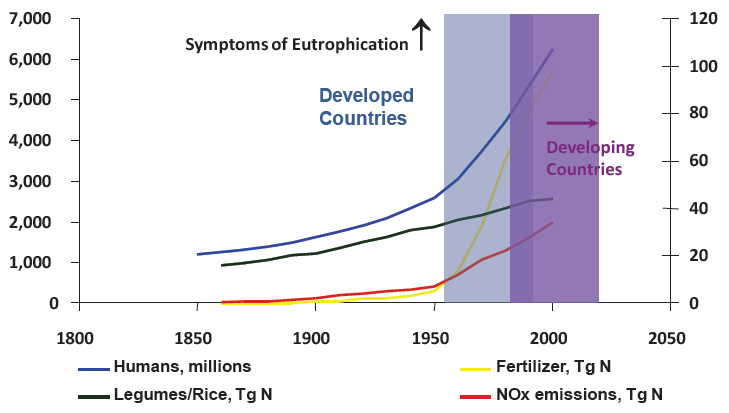Graph of the Day: Symptoms of Coastal Eutrophication, 1850s – 2000s
Period in which the symptoms of eutrophication and hypoxia / anoxia began in developed countries and how the symptoms are shifted to more recent years for developing countries (modified by N. N. Rabalais from Galloway and Cowling, 2002; Boesch, 2002). The occurrence of hypoxia in coastal areas is increasing, and the trend is consistent with the increase in human activities that result in increased fluxes of nutrients to waters. More and more coastal systems, especially in areas of increased industrialization and mechanized farming, where the physical conditions are appropriate and where nutrient loads are predicted to increase, will likely become eutrophic with accompanying hypoxia (Fig. 15). The continued and accelerated export of nitrogen and phosphorus to the world’s coastal ocean is the trajectory to be expected unless societal intervention in the form of controls or changes in culture are pursued. The largest increases are predicted for southern and eastern Asia, associated with predicted large increases in population, increased fertilizer use to grow food to meet the dietary demands of that population and increased industrialization (Seitzinger et al., 2002). Increased production of biofuels in many countries will further amplify nutrient delivery from the land to the sea (National Research Council, 2008; Simpson et al., 2008). The implications for coastal eutrophication and subsequent ecosystem changes such as worsening conditions of oxygen depletion are significant. Depending on the coastal environment, the residence time of river-supplied freshwater and rates of nutrient uptake and regeneration, the changes observed in the Anthropocene (Meybeck, 2003) from increased nutrient loads are most likely to lead to human-caused eutrophication and associated hypoxia. This does not preclude the potential for climate-driven changes in oceanic nutrient sources from exacerbating an already precarious situation.
N. N. Rabalais, R. J. Díaz, et al., Dynamics and distribution of natural and human-caused hypoxia [pdf], Biogeosciences, 7, 585–619, 2010
